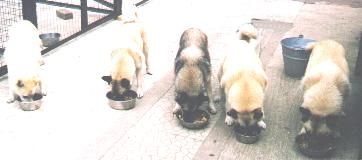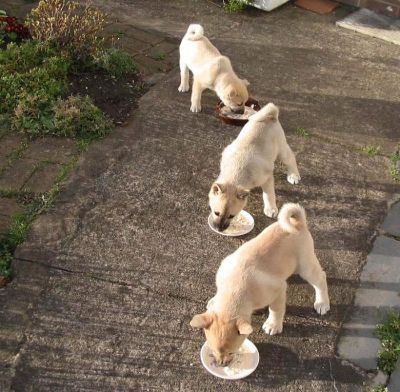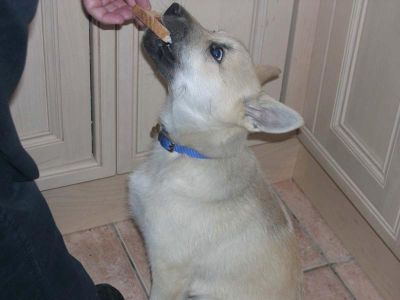| | 
It is hardly surprising that owners become very confused about dog food. There is such an amazing amount of choice of brands, types of food and places to buy it. How you eventually decide to feed your dog is a matter of personal choice, based on price, convenience and, of course, how a certain food suits your dog.
Buhunds do not need great amounts of rich or expensive types of food and they only become fussy if allowed to do so. Once you find a food that suits your dog, stick to it.
When a new owner collects his Buhund puppy from his breeder, he will be given a diet sheet detailing the foods, rough amounts, and times of feeding. He will probably also have a few days supply of food as well. However, you plan to feed the puppy in the future, stick to the diet given by the breeder for the first few weeks at least or the puppy may well end up with an upset tummy. The key to changing over foods is to do it gradually.

The basic choices in feeding are:
· A complete diet.
· “Traditional” mix of tinned dog meat and biscuit.
· Semi-moist.
· A raw or BARF diet.
Complete Diet
This is a commercially produced diet that is supposed to provide all the nutrients required by a dog and usually comes in a dry biscuit form. These days there are many different complete diets covering all types of dogs of all ages, including “light” diets for overweight dogs. They are designed to be fed alone although most owners cannot resist adding a little something to the dog’s meal. Many dogs seem to do very well on these diets although others do develop allergies and suffer skin problems that disappear when their diet is changed. Some people have ethical issues with some of the large companies that produce dog food regarding their use of animals for testing. There are many different brands of complete food and a great range of prices. Generally speaking, the cheaper brands tend to consist of a large amount of cereal which is not a particularly good ingredient for dogs who do not need cereal in their diet. For Buhunds, beware of those that have a very high protein content. I have found that puppies fed on a complete diet grow more quickly than those fed on a raw diet – not necessarily a good thing. Also beware of compete foods which have a variety of different colours. These are put in purely to make the food look more attractive to the dog’s Human. Dogs don’t care what colour their dinner is and artificial colours are not a necessity.

Tinned food and biscuit:
This is a food that has been popular for a good number of years for its convenience, the fact there it allows a measure of variety and because dogs tend to enjoy it. When feeding biscuit, it should be remembered that the tinned food also contains cereal. Cheaper brands such as Chappie tend to suit Buhunds better than brands that are more expensive but tend to give many dogs diarrhoea.
Semi Moist
There are now a number of these types of diet available, they are generally vacuum packed and some are well recommended by those who have used them. They tend to a little more expensive than other commercial dog foods.
Raw or BARF Diet
There is a growing number of dog owners who have returned to feeding a raw or BARF (Bones And Raw Food) diet to their dogs due to their own experiences or growing disquiet about commercial diets. Raw diets can be as simple or as complicated as owners wish to make it. There are now a number of books on the subject and also numerous web sites. Basically, raw meat, including offal, raw poultry and other bones, vegetables, fruit and eggs are all fed. Very few dogs suffer any ill-effects from this diet but care must be taken to ensure that dogs have a well balanced diet and are provided with all the nutrients necessary for health.
 Toast! (photo: M. Fryatt) Toast! (photo: M. Fryatt)
Whatever you decide to feed your Buhund, remember he does not need as much food as he will try to persuade you that he needs! As an adult, a Buhund can be fed once or twice a day with very few treats in between meals. Never leave uneaten food down, apart from teaching your dog bad habits it can be very unhygienic. If he hasn’t eaten all his food within ten minutes, pick it up & throw it away. For his next meal, reduce the amount of food you give him and continue to do this until he is eating his food almost immediately. If he is fed a complete diet he will need much more water available than if he is fed another diet.
| |
























 Toast! (photo: M. Fryatt)
Toast! (photo: M. Fryatt)